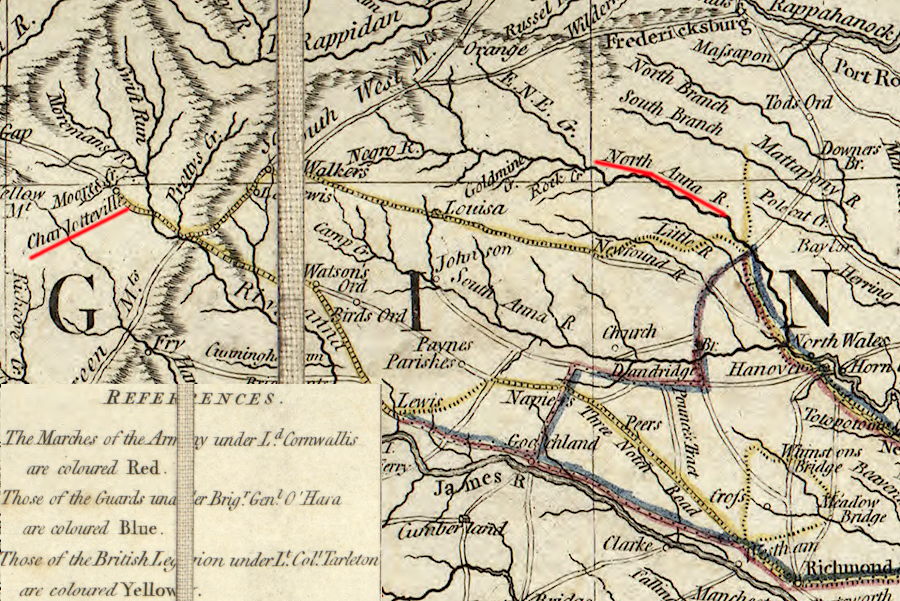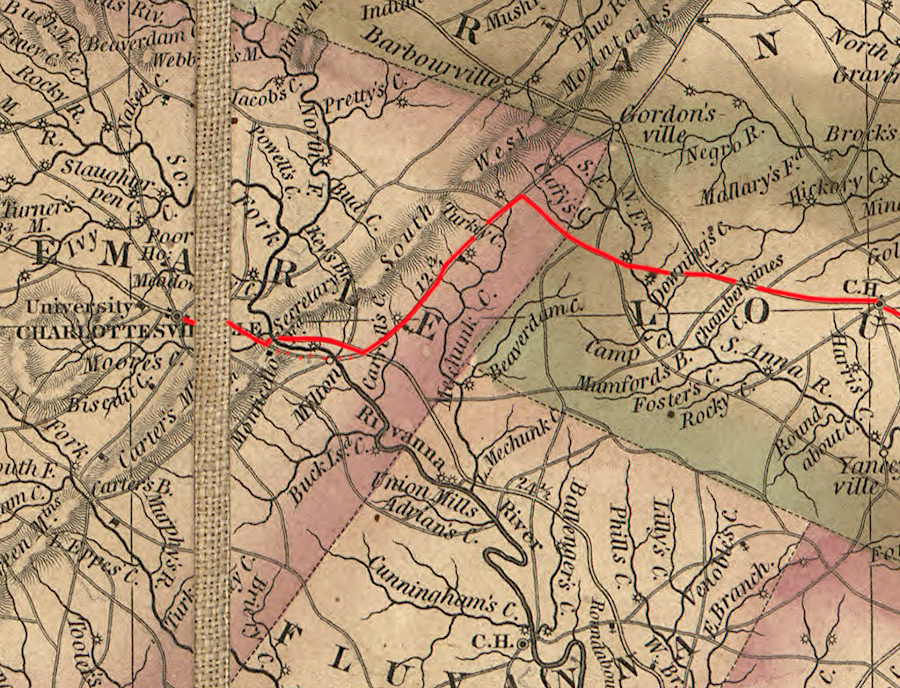Race to Charlottesville: Jack Jouett and Banastre Tarleton

British cavalry under Banastre Tarleton sought to capture General Assembly officials and Gov. Thomas Jefferson on a raid from the North Anna River to Charlottesville in June, 1781
Source: Library of Congress, The marches of Lord Cornwallis in the Southern Provinces (by William Faden, 1787)
By June, 1781, Lord Cornwallis had marched from Petersburg to the North Anna River and was considering going to Fredericksburg and destroying Hunter's Iron Works across the river at Falmouth. Major General Marquis de Lafayette had only enough forces to threaten and harass the British.
After Brigadier General "Mad" Anthony Wayne brought Pennsylvania Continental Line troops, Lafayette's force grew to 4,000 men. However, he continued to avoid a battle because Cornwallis commanded over 7,000 well-trained, battle-hardened troops.
Rather than go north to Fredericksburg, Cornwallis chose to split his army in order to capture two different targets.
He sent Col. John Graves Simcoe to capture the Continental Army supply depot at Point of Fork. That place was guarded by forces commanded by Baron Friedrich Von Steuben. Simcoe successfully bluffed the Americans onto retreating, then took his time destroying the depot.
Cornwallis also dispatched Col. Banastre Tarleton to Charlottesville to disrupt the General Assembly meeting there. The state legislature had fled from Richmond on May 10, as Cornwallis had moved north from Petersburg and crossed the James River. Thomas Jefferson, finishing his term as governor, lived at his Monticello plantation nearby on the Rivanna River.1
The British army had marched north from Charleston, but had not been powerful enough to leave any of its regiments behind to fortify the interior. Cornwallis expected Tories to retain control of the Carolinas as he moved into Virginia.
Tarleton left from Hanover Court House. He had 180 dragoons (heavily-armed cavalry) from his own British Legion. They were loyalists, Americans who had demonstrated a willingness to kill American rebels rather than allow them "quarter" as they surrendered. Tarleton got the blame and "Bloody Ban" Tarleton was considered a butcher by the American rebels, while Cornwallis considered him to be a highly-effective military leader who could move swiftly and catch the enemy unprepared.
Taleton also had 70 mounted infantry from the 23rd Regiment, the Royal Welsh Fusiliers.
Tarleton's objective was to capture top Virginia officials, especially the author of the Declaration of Independence. Morale of the American rebels would drop; that could reduce enlistments in the militia and Continental Army. Ideally, seizing the Virginia leaders also would stimulate Tories in Virginia to organize and take control of that colony, as Cornwallis had sought on his march from Charleston to arrange for South Carolina and then North Carolina.
On the night of June 3, local Louisa County resident Jack Jouett saw the British at Cuckoo Tavern. He knew the General Assembly had moved to Charlottesville three weeks earlier, since some members frequented his father's Swan Tavern in the town. His father had opened it after selling Cuckoo Tavern in 1773.
Jouett followed the British column from Cuckoo Tavern to Louisa Courthouse. There he managed to get around them, using a local side road which he knew. He raced to Charlottesville while the British gave themselves and their horses a rest between 11:00pm-2:00am.
By following farm patch and logging roads, Jouett crossed the South Anna River to reach the Three Notched Road. That was the main path between Richmond and Charlottesville, one without the overhanging branches which had whipped across his face.
Jack Jouett rode all night, going perhaps 40 miles. He reached Monticello before daylight. There he warned Thomas Jefferson plus his guests, including the leaders of the House of Delegates and State Senate. He then went down the mountain into Charlottesville to alert Virginia officials about the coming raid.
The British stopped for only 30 minutes at the home of Dr. Thomas Walker, Castle Hill. A contingent visited Belvoir, the plantation owned by Walker's son, and captured one member of the Continental Congress from South Carolina there. Tarleton's troops had ridden 70 miles from Hanover Court House to get to Charlottesville, but he lost the advantage of surprise and the opportunity to capture Virginia's top leaders. Tarleton's longer route, and Jack Jouett's athletic ride through the dark on narrow paths without a long pause to rest, determined who arrived first.

most British cavalry under Banastre Tarleton racing to Charlottesville crossed the Rivanna River at Secretary's Ford, while a small force crossed at Milton Ford to capture Thomas Jefferson
Source: Library of Congress, A map of the state of Virginia : reduced from the nine sheet map of the state in conformity to law(by Hermann Boye, 1827)
Jefferson fled to his property in Bedford County, where later he built Poplar Forest. Most leaders in Charlottesville, including Patrick Henry and several signers of the Declaration of Independence, scattered before the British arrived.
The General Assembly managed to reassemble in Staunton at Trinity Church and elect a new governor. It also voted to award Jouett a sword and pair of pistols, in thanks for his timely warning. He may have received the pistols in 1786, when he came to Richmnd to represent Lincoln County (now in Kentucky) in the General Assembly. It is unclear if the sword was ever presented to him.
Seven legislators were captured, including Daniel Boone. None were important enough to detain long, or to use for propaganda.
Paul Revere's ride to warn the militia at Lexington and Concord in 1775 is nationally known, thanks to the powerful poetry of Henry Wadsworth Longfellow. The significance of Jouett's ride, as least as dramatic, is commonly known only in one region of Virginia.2
Links
- Encyclopedia Virginia
- Kentucky History
- Monticello
References
1. "032-0026 Point of Fork Arsenal Archaeological Site," Virginia Department of Historic Resources, https://www.dhr.virginia.gov/historic-registers/032-0026/; H. J. Eckenrode, "The Story of the Campaign And Siege of Yorktown," 1931, https://www.newrivernotes.com/topical_books_1781_virginia_siegeofyorktown.htm (last checked May 1, 2020)
2. Rick Britton, "From Cuckoo To Charlottesville: Jack Jouett’s Overnight Ride," Journal of the American Revolution, March 5, 2013, https://allthingsliberty.com/2013/03/from-cuckoo-to-charlottesville-jack-jouetts-overnight-ride/; John R. Maass, "To Disturb the Assembly: Tarleton's Charlottesville Raid and the British Invasion of Virginia, 1781," Virginia Cavalcade, Autumn 2000, https://fusilier.wordpress.com/banastre-tarleton-article-2000/; Lieutenant-General Banastre Tarleton, A history of the campaigns of 1780 and 1781, in the southern provinces, Printed for Colles (Dublin), 1787, pp.301-305, https://hdl.handle.net/2027/yale.39002002440338 (last checked May 6, 2020)
(last checked May 6, 2020)
The Revolutionary War in Virginia
The Military in Virginia
Virginia Places

